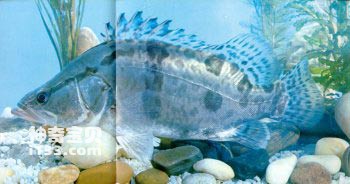Mandarin fish (Siniperca spp) belongs to the order Perciformes, family Siniperidae, subfamily Siniperca, and genus Siniperca. Commonly known as: mandarin fish, season fish, mandarin fish, mandarin fish, mandarin fish. English name: Chinese perch.
The body is tall and flat on the sides, with a raised back. The mouth is large, with the lower jaw obviously longer than the upper jaw. There are small teeth of different sizes on the upper and lower jaws, vomers, and oral bones. The posterior edge of the anterior operculum is serrated, with 4 large spines on the lower edge; and the posterior edge of the posterior operculum has 2 large spines. The head is scaly and the scales are small; the lateral line curves upward along the dorsal arc. The dorsal fin is divided into two parts, connected to each other, with hard spines at the front and soft fins at the back. The body is yellow-green, the abdomen is gray-white, and there are irregular dark brown spots and patches on the sides of the body; there is a narrow black band from the snout through the orbit to the front and bottom of the dorsal fin.

Mandarin fish generally inhabit still water or slow-flowing water bodies, especially in lakes with lush aquatic plants. They are inactive in winter and often spend the winter in deep water. They generally do not completely stop feeding. When the weather gets warmer in spring, they swim to the shallow waters along the coast to look for food. At this time, both male and female fish have the habit of lying on their sides in the depressions at the bottom of the lake during the day, and move and look for food in the aquatic plants at night. Mainly feed on other fish, with poor feeding in January-February, the most vigorous in June-July, and a slight decrease in feeding intensity during the reproductive period. Mandarin fish usually reach 2 winters in age, but in the Northeast they do not reach sexual maturity until 3 winters in age. The broodstock gather in groups at night to lay eggs in gentle flowing water from May to July. June to July is the peak period of egg laying, and the number of eggs carried is 30,000 to 200,000.
There are two common types of mandarin fish, with very similar appearances. The difference is: S. chuatsi (English name: Mandarinfish, Aukua) has 7 gill rakers, smaller eyes, and a head length of 5.3-8.1 times the eye diameter. The maxilla extends below the posterior edge of the eye, the lateral line scales are 110-142, the lower cheek has scales, and the pylorus has 198-440 scales. The gill rakers of S.kneri (English name: Bigeye mandarinfish) are 6, the eyes are larger, the head length is 4.7-5.1 times the diameter of the eyes, the maxilla only extends to the lower part in front of the posterior edge of the eyes, and the lateral line scales are The number is 85-98, the cheek is not scaled, and the number of pylorus is 74-98. The upturned-billed mandarin fish grows quickly and is large in size, usually weighing 2-2.5 kilograms, and the maximum individual weight can reach 50 kilograms; the big-eyed mandarin fish grows slowly and is smaller in size, with the maximum individual weighing 2 kilograms.
Mandarin fish are widely distributed in rivers and lakes in the eastern plains of China. Natural yields are quite high. The meat is white, tender and delicious, without small thorns, and rich in protein. Each 100 grams of edible part contains 15.5-19.3 grams of protein, 0.4-3.5 grams of fat, 78-109 kcal of calories, 79-206 mg of calcium, 107-143 mg of phosphorus, 0.7-5.6 mg of iron, and 0.01 mg of thiamine. Riboflavin 0.10 mg, niacin 1.9 mg. Mandarin fish has been listed as one of the rare fishes since ancient times. Among the funerary objects unearthed in the Mawangdui Han Tomb in 1972, there was a mandarin fish! The pylorus of mandarin fish is many and clustered, so it is commonly known as sweet-scented osmanthus fish. Its flavor is fragrant, crispy and delicious. It can be said that "if you have mandarin fish on the table, you can even leave the bear's paws." It is worth noting that the 12 dorsal fin spines, 3 anal fin spines and 2 pelvic fin spines of mandarin fish all have venom glands. If you are stung, you will experience severe swelling and pain, fever, and chills. This is a stinging sting in freshwater stinging fish. One of the most painful. Special care should be taken when catching and killing mandarin fish.
Mandarin fish meat is sweet, flat, non-toxic, and has the effects of replenishing deficiency and fatigue, and benefiting the spleen and stomach. Its tail can cure soft boils in children, and its gallbladder can cure bone in the throat.
animal tags:
We created this article in conjunction with AI technology, then made sure it was fact-checked and edited by a Animals Top editor.